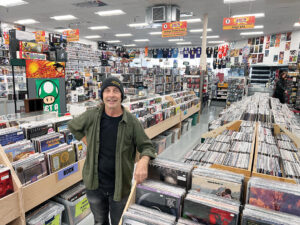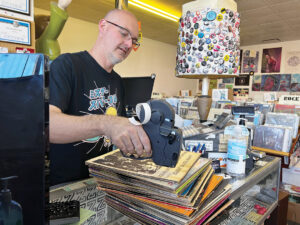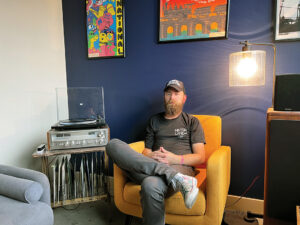The return of record shops
11/30/2022
Mike Enloe at Jay’s CD and Hobby on S.E. 14th Street. Photo by Colson Thayer
Mike Enloe may have been a struggling student at Drake University in 1975, but he kept an eye on the music industry. He decided to take a chance and open his own record store.
“My wife and I hopped in a car one day; we drove down Ingersoll Avenue looking for this building for rent,” Enloe said.
He immediately fell in love with a quaint little shack on Ingersoll’s 3700 block next to the Ingersoll Dinner Theater. He began renting out the space in the winter of 1975. On March 15, 1976, Peeples Music Shoppe was born. It became a staple of Des Moines’ music industry for decades.
Over the course of almost 50 years in the industry, Enloe has seen drastic changes in the way people consume their music. It began with LP records, then the advent of CDs, the growth of downloading and streaming and, eventually, a resurgence in traditional forms of music media. To be successful, Peeples and other Des Moines record stores needed to exemplify business flexibility to stay afloat. Today, a steady increase in the sales of physical music formats shows promising signs for the future of record shops.

Nate Niceswanger owns Zzz Records. Photo by Colson Thayer
LP Records
When Enloe first opened Peeples in the late 1970s, LP records were the primary format of music consumption.
“Records were a real viable thing,” he said. “In no time, really, I was running a successful business.”
But, at the time, there was plenty of competition. Stores like Music Circuit, Music Land, Music Factory and others competed for the same business. In fact, all these stores were selling the same items.
“I’d imagine that every store was pretty much like me. We all sold the same thing, really. All the record salesmen all went to the same stores,” he said. “Des Moines was a viable market where every record company had a rep that came by once a month to sell his new releases.”
By 1980, customers had two main options — LP records or cassettes — but people continued to enjoy the glamor of LPs. They not only included the visual cover art, but Enloe considered them to have better sound quality as well.

Luke Dickens owns and operates Vinyl Cup Records in Beaverdale, Omaha and Cedar Falls. Photo by Colson Thayer
Enloe’s business was doing well enough, and he opened a second location in Ames. He described it as a “hole-in-the-wall” store. He advertised it as a hidden record store on Lincoln Way, and students loved it.
CDs
“By 1985, the record hype was gone. It slowly got replaced by CDs,” explained Enloe.
By 1987, LPs were near-obsolete, and they were not being sold in stores anymore. Record companies quit producing new albums and began to run out of titles. Customers quickly adapted to the new technology. When CDs were first introduced, CD players cost anywhere from $500-$1,000. However, within a few years, those prices dropped substantially. After two years, CD players were everywhere, even in cars.
“People were buying CDs like crazy from 1985 till 1998,” Enloe said. “Everybody had to have them — everybody.”
The exciting new technology is considered the driving factor for the popularity of CDs in the mid-1980s, but they had another thing working in their favor, too: the rising prices of LPs. Record companies continued to raise the price of records as the years went on. Famously, Tom Petty protested the rising prices of LPs and threatened to withhold his album “Hard Promises” in 1981 when MCA Records announced it would raise the price of their albums by a whole dollar.
Napster
1999 saw the release of Napster, a digital file distribution software that revolutionized the way people listened to music. Consumers could easily download music onto CD-Rs. While this made music much more accessible, it proved to be a challenge for independent record stores.
“You can’t beat free,” said Enloe. Both his Ames store and his metro store held steady business until the release of Napster. He found Iowa State students would go to the computer labs and record their music on discs instead of visiting his store. Enloe had to close his Ames store in 2000. Meanwhile, his metro store continued to struggle.
Napster affected not only Enloe’s businesses but the entire industry. Independent record stores in the metro area also began to close their doors. Nate Niceswanger saw this as an opportunity to open his own business.
Zzz Records
Niceswanger was a record collector. He would often travel to other cities like Minneapolis, Iowa City, Omaha and Sioux City to find additions to his collection. He realized that these cities, some larger than Des Moines and some smaller, had way more record shops.
“There’s 75,000 people in Sioux City; they got three stores. We got a couple hundred thousand people, and we have zero,” he realized.
“Finally, I got the nerve and quit my job and decided to just go for it. My goal was just to see if I could make it a year.”
And every year since, his goal has stayed the same: make it one more year. He had his 22nd anniversary in 2022.
“In the beginning, I was smart enough to know that not everyone had a record player at that time… it was not the cool thing to have,” Niceswanger said.
When he first opened his doors, his inventory was two-thirds vinyl and one-third CDs.
Niceswanger didn’t carry the big names in music at the time like Mariah Carey or Britney Spears. Instead, he offered what he considered to be more alternative music including Neutral Milk Hotel, Death Cab for Cutie, White Stripes and The Strokes, among others.
Zzz Records became the only independent music store in town when Enloe had to close his doors in 2006.
“CDs were a pretty big part of our store up until about 2007 or maybe 2008, and that’s when the recession hit,” Niceswanger said.
At that time, high-speed Internet became much more reliable and available. Consumers could start listening to music from their phones.
“[Technology] changed the ways CDs were selling pretty dramatically, and CD sales really tanked. Luckily, right around that time, vinyl sales started to take off.”
Resurgence of vinyl
Since 2010, vinyl record sales have seen a steady increase, as have the number of record shops in the metro. It is hard to say for certain why vinyl records are on the rise again, but Niceswanger had a few guesses.
“There’s something about having a physical copy in your hands,” he said. “Vinyl, especially, is exciting to people because you got the larger artwork; you got a 12×12 picture as opposed to a CD.”
Luke Dickens agreed that listening to vinyl is a completely different experience.
“It’s one thing to throw on a Bluetooth; it’s another thing to pull out a record and pass the cover around, read the liner notes, look at the title of the song, look at the cover and the art behind it — it’s a piece of art.”
Dickens owns and operates Vinyl Cup Records in Beaverdale, Omaha and Cedar Falls. The business was born out of a Facebook group Dickens started in August 2017 with 40 people. In February 2018, the group had grown to 2,000 members, and the size of his basement record collection was 20,000. At his partner’s request, Dickens moved his collection and business to his current Beaverdale location.
In March 2019, Marv’s Record Shop in the East Village was going out of business. Dickens bought it out and brought it back to life. Marv’s sells new records while Vinyl Cup primarily sells used vinyl. On the surface, Marv’s and Vinyl Cup appear to be very similar businesses, but to Dickens, they are quite different.
“I feel like Marv’s is the beginning to a new story and Vinyl Cup is a way to carry on a story.”
Dickens doesn’t think Marv’s is as personable as Vinyl Cup, but they both serve their own clientele.
The age of streaming
“There’s another record store that says ‘Spin, Don’t Stream.’ I tell them to shut the hell up,” said Dickens.
He said he thinks record shops and streaming services can coexist.
“People can listen to a new record released Friday on Spotify or Apple, any streaming service that they use… They know if they want it or not, [and then] they go to the record store and buy it.”
“It doesn’t really concern me too much,” Niceswanger explained. “There are going to be some people that just listen to music for free their entire life.”
Dickens recognizes the pros and cons of streaming. On one hand, musicians are paid pennies for each time their music is streamed. However, without it, their music might never be heard. Streaming is an opportunity for consumers to get exposed to new music.
“I think streaming is a great gateway. I don’t think it’s the primary way to listen,” Dickens said. “I also think vinyl has a more wholesome authentic sound that you’re not going to get from streaming.”
The hope is consumers exposed to new music through streaming will end up buying physical copies of music, supporting both local record shops and the artists themselves. ♦





















